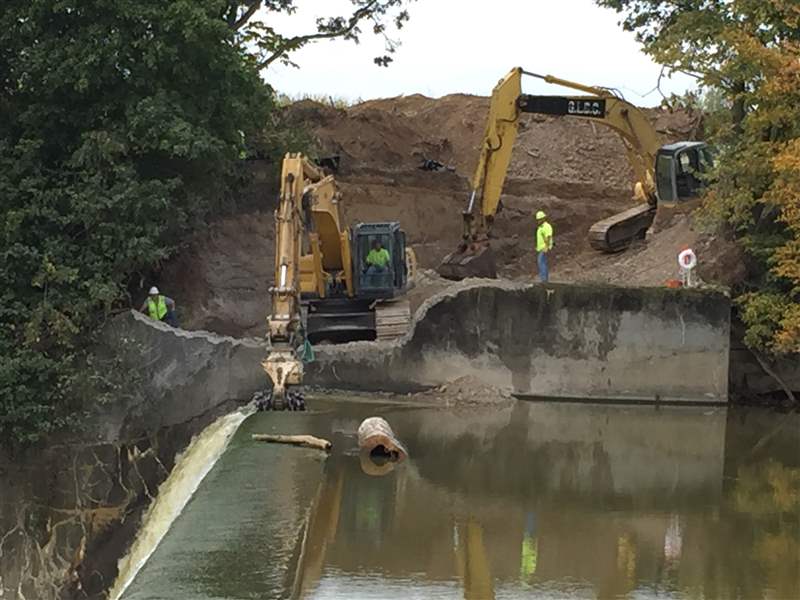
Demolition begins at Fremont's Ballville Dam
9/13/2017
Workers begin to grind down a segment of the Ballville Dam in Fremont, Ohio on September 13, 2017.
THE BLADE/JETTA FRASER
Buy This Image
FREMONT — The first phase of the Ballville Dam's demolition has begun, but the Sandusky River won’t again flow unimpeded past the site until next year.
Great Lakes Demolition began grinding a notch into the dam's east end Wednesday morning that, when finished, will be about 10 feet deep into the 30-foot high structure, and 20 feet wide.
The notch will allow much of the impounded water behind the dam to flow out gradually before the entire structure’s removal, Fremont city Engineer Tucker Fredericksen explained while watching the work crew chip away at the notch using a backhoe equipped with a rock-grinding head.
“Everything’s going to plan — so far, so good,” Mr. Fredericksen said 90 minutes after work began around sunrise. “It should drain out fairly quickly, as long as we don’t get too much [rain] in the watershed to recharge it.”
By midday, the notch appeared close to its 10-foot goal. Except for one small piece that will remain to shore up part of the riverbank, the rest of the dam will be removed next year, he said.
During the time in between, the city will relocate local mussels that live in the river bottom areas exposed by draining, then seed and stabilize those areas.
Great Lakes Demolition is a subcontractor for a $1.6 million city contract with Cleveland-based MWH Construction for initial stages of the dam’s removal. That contract also includes the seeding and stabilizing to be done later, as well as the construction early this year of an ice-control barrier just downstream of the bridge to prevent ice jams in downtown Fremont once the dam is gone.
A U.S. Fish & Wildlife Service grant is underwriting much of the dam removal’s cost.
Fremont Mayor Danny Sanchez said the dam’s removal should make the Sandusky better suited for recreational activities in the area and thus boost the city’s tourism.
“The river is one of the most underutilized resources we have in the city of Fremont,” he said.
Without the dam, the river’s ecology also will improve, said Mike Wilkerson, the fish management supervisor at the Ohio Department of Natural Resources district office in Findlay. Mr. Wilkerson was part of an ODNR Division of Wildlife delegation that observed the demolition’s start.
“Fish can migrate farther upstream, and the river will have better water quality once it reverts to its natural state,” he said.
The dam's removal had been the subject of controversy during its planning stage, based on fear that accumulated sediment upstream would wash into Sandusky Bay and Lake Erie.
But the Sierra Club's Ohio chapter dropped a lawsuit seeking to require that sediment's prior removal once the Army Corps of Engineers imposed on the project conditions intended to mitigate the potential flow.
By Wednesday the ice-control barrier, comprising 15 large bollards of steel-encased concrete, had accumulated a significant pile-up of dead trees and other debris that had gone over the dam during recent floods. City officials said they plan to remove that debris.
Outdoors Editor Matt Markey contributed to this report.